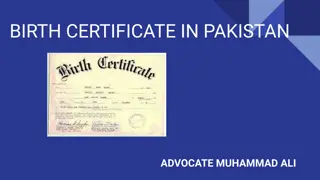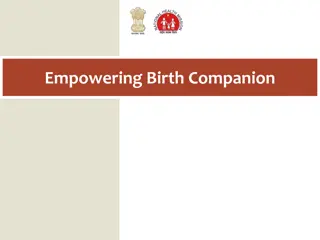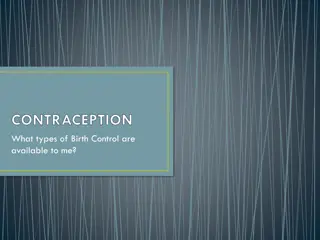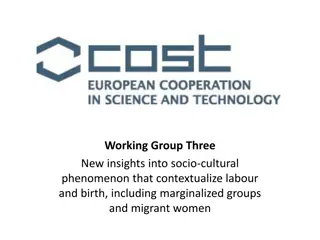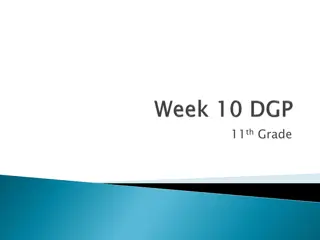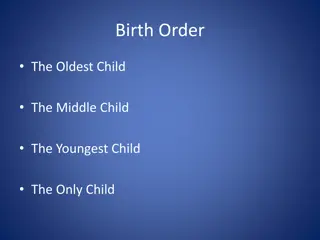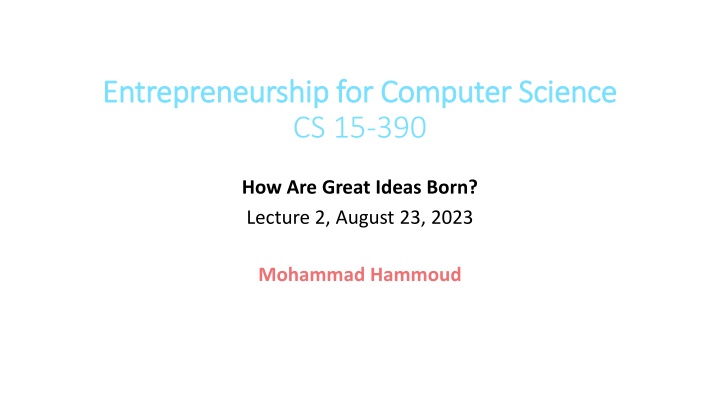
Entrepreneurship Paradigms and Ideas Generation
Explore the process of entrepreneurship in computer science, focusing on the birth of great ideas and the two types of entrepreneurship - Small and Medium Enterprise (SME) and Innovation-Driven Enterprise (IDE). Learn about the essential functions within the entrepreneurship paradigm, from identifying a market to scaling and exiting a business. Understand the differences between SME and IDE in terms of market focus, innovation, job creation, and capital requirements. Discover the key principles and steps to conceiving and developing successful entrepreneurial ideas in the tech industry.
Download Presentation

Please find below an Image/Link to download the presentation.
The content on the website is provided AS IS for your information and personal use only. It may not be sold, licensed, or shared on other websites without obtaining consent from the author. If you encounter any issues during the download, it is possible that the publisher has removed the file from their server.
You are allowed to download the files provided on this website for personal or commercial use, subject to the condition that they are used lawfully. All files are the property of their respective owners.
The content on the website is provided AS IS for your information and personal use only. It may not be sold, licensed, or shared on other websites without obtaining consent from the author.
E N D
Presentation Transcript
Entrepreneurship for Computer Science Entrepreneurship for Computer Science CS 15-390 How Are Great Ideas Born? Lecture 2, August 23, 2023 Mohammad Hammoud
Today The birth of great ideas: The two types of entrepreneurship How to conceive a great idea? Principle 1: Know your why Announcements: The course website is up and running: http://www.qatar.cmu.edu/~mhhammou/15390-f23/index.html Email me your team (the names) by Monday, August 28, 11:59PM
Entrepreneurship Paradigm A System of Functions Paradigm: Functions Identify & Research a Market Found or Co-found a Company Build a Business Model Identify a Problem Build a Prototype Bootstrap and/or Raise Angle Fund Raise Market & Operate Build a Culture Build an MVP Professional Money Scale Exit
Entrepreneurship Paradigm A System of Functions Paradigm: Functions Identify & Research a Market Found or Co-found a Company Build a Business Model Identify a Problem Build a Prototype Bootstrap and/or Raise Angle Fund Raise Market & Operate Build a Culture Build an MVP Professional Money Scale Exit
Entrepreneurship Entrepreneurship is the process of creating a sustainable business There are two types of entrepreneurship Small and Medium Enterprise (SME) Innovation-Driven Enterprise (IDE) SME SME SME SME SME SME IDE IDE IDE IDE IDE IDE Market Market Market Market Market Market Local and/or Regional Local and/or Regional Local and/or Regional Local and/or Regional Local and/or Regional Regional/Global Regional/Global Regional/Global Regional/Global Regional/Global Invention Invention Invention Invention Invention Invention Not Necessary Not Necessary Not Necessary Not Necessary Necessary Necessary Necessary Necessary Jobs Jobs Jobs Jobs Jobs Jobs Non-tradable Non-tradable Non-tradable Tradable Tradable Tradable External Capital External Capital External Capital External Capital External Capital External Capital Typically No Typically No Yes Yes Growth Growth Growth Growth Growth Growth Linear Exponential
SME and IDE Expected Revenue & Job Trends Revenue & Jobs Revenue & Jobs Burning Area Time Time : Much Riskier, but : Usually Not Risky IDE More Ambitious (Go Big or Go Home!) SME
SME and IDE Expected Revenue & Job Trends Revenue & Jobs Revenue & Jobs Burning Area The Focus of this Course! Time Time : Much Riskier, but : Usually Not Risky IDE More Ambitious (Go Big or Go Home!) SME
Purposes for Starting a Business Why do people start IDEs? To improve on something that seems obsolete To invent something new that fills a void in the market To revolutionize an entire industry Etc., What is that thing or this industry? You need to identify the problem before you come up with an idea that solves that problem People commonly refer to both things (i.e., problem finding and idea generation) as one thing (i.e., idea generation), signifying the importance of the outcome, when they really mean both
Types of IDEs To this end, there are two types of IDEs An IDE that knows a problem but is searching for a solution E.g., Medical diagnostic errors is a serious problem in healthcare that you may want to solve, but you may not know the solution right away, thus need to conduct research An IDE that knows a problem and its solution E.g., Scheduling an appointment with a doctor through classical means might be a problem (your hypothesis) and providing people with an app to do it conveniently might be the solution (your thesis) The intersection of personal passion andproblem solving is where good IDEs are born, and lasting businesses are built
How to Conceive IDEs? Paul Graham (the cofounder of Y Combinator) says: The way to get startup ideas is not to try to think of startup ideas. It s to look for problems, preferably problems you have yourself It sounds obvious to say you should only work on problems that exist. And yet by far the most common mistake startups make is to solve problems no one has. People in this context are three: Hobbyist: A person who creates something purely out of passion Tinkerer: A person who creates something out of passion that solves a problem only they have Entrepreneur: A person who creates something out of passion that solves a problem they share with lots of people
Principle 1 Principle 1: Know Your Why Why is Apple way more innovative than all its competitors? Why Martin Luther King lead the civil right movement in the USA, although he was not the only man who suffered in the pre-civil rights America? The famous author Simon Sinek says: All the great and inspiring organizations and leaders think, act, and communicatethe same way.
Principle 1 Principle 1: Know Your Why The golden circle (by Simon Sinek): Few people think inside-out; Few marketing is done this way Why? Vey few know why they do what they do How? Some know how they do it What? Most people think outside-in; Most marketing is done this way Every single organization knows what they do
Principle 1 Principle 1: Know Your Why The golden circle correlates with the human brain Neocortex System 1 thinking is a near-instantaneous process; it happens automatically, intuitively, and with little effort. It s driven by instinct and our experiences (by Daniel Kahneman) System 2 thinking is slower and requires more effort. It is conscious and logical (by Daniel Kahneman) Speech, logic, and higher thinking skills Limbic System Feelings (e.g., loyalty) Reptilian Brain Instinct It controls behavior and decision-making (or more precisely gut decisions)! Even when we think that we are being rational in our decisions, our System 1 beliefs and biases still drive many of our choices
Principle 1 Principle 1: Know Your Why The golden circle correlates with the human brain Neocortex When we communicate from outside-in, people can understand our presented complicated information (e.g., features, benefits, facts, and figures) But, when we communicate from inside-out, we are talking directly to the part of the brain that controls behavior and we allow people to rationalize it with the tangible things we say and do Speech, logic, and higher thinking skills Limbic System Feelings (e.g., loyalty) This does not necessarily drive behavior! Reptilian Brain Instinct
Principle 1 Principle 1: Know Your Why Say, Apple thinks, acts, and communicates as follows: We make great computers (What?) They are beautifully designed and easy to use (How?) Will you buy? Outside-in Alternatively, say, Apple thinks, acts, and communicates as follows: Everything we do we believe challenges the status quo (Why?) They way we do it is through beautiful and easy-to-use designs (How?) Which happens to result in great computers! (What?) Will you buy? Inside-out
Principle 1 Principle 1: Know Your Why The goal is not to do business with everybody who needs what you have; the goal is to do business with people who believe what you believe Dell came out with MP3 players and PDAs and no one bought them The goal is not to hire people who need jobs; the goal is to hire people who believe what you believe Who is Samuel Pierpont Langley? He was as an American aviation pioneer, astronomer, and physicist Who are the Wright brothers, Orville Wright and Wilbur Wright? They were American aviation pioneers who invented the world's first successful motor- operated airplane in 1903
Principle 1 Principle 1: Know Your Why Samuel Pierpont Langley Was given $50,000 by the War Department to invent a flying machine (money was not a problem) He held a seat at Harvard He was extremely well-connected and knew all the big minds of the day He hired the best minds money could find The New York Times followed him around everywhere And everyone was rooting for him
Principle 1 Principle 1: Know Your Why The Wright brothers They had no money They paid for their dream from the proceeds of their bicycle shop Not a single person in their team had a college education (not even Orville and Wilbur!) The New York Times followed them around nowhere And maybe no one was rooting for them
Principle 1 Principle 1: Know Your Why Why did the Wright brothers succeed where Samuel Langley failed? The Wright brothers had a belief that if they can figure out this flying machine, the course of the world will change Samuel Pierpont Langley was driven by money; when the Wright brothers succeeded, he quitted The people who worked for the Wright brothers, worked with blood, sweat, and tears The people who worked for Samuel Pierpont Langley, worked for the paychecks When the Wright brothers succeeded in December 17, 1903, no one was there to experience it except one local journal (although they notified the press!)
Next Class How to identify your market and validate the potential of your idea?


